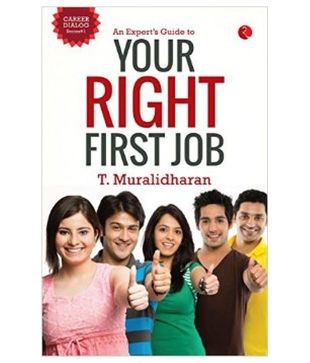Authored by T Muralidharan, An Expert’s Guide to Your First Right Job — published by Rupa & Co.— highlights the importance of knowing one’s personality, finding the right industry, choosing the right first employer and other such important decisions related to one’s career.
Many successful professionals have gone through a phase when they have questioned themselves – Am I in the right job? This realisation often turns out to be the turning point of their’ career provided it comes in early in their professional journey. People often wish for a mentor, who could help them find the way.
Here is a book for those who want to jumpstart their career or are trying to give a direction to their career.
Authored by T Muralidharan, an alumni of IIM Ahmedabad, An Expert’s Guide to Your First Right Job — published by Rupa & Co.—is meant for young graduates and those who are in the early stages of their career. It aims to help them take up the right jobs and make the right career decisions. HR managers can also gain from this book by learning how to tap the right kind of talent.
The book highlights the importance of knowing one’s personality, finding the right industry, choosing the right first employer and other such important decisions related to one’s career.
It contains 18 short chapters, with the first devoted to defining the term ‘right first job’ (RFJ). It provides an insight into a company’s way of recruiting and the importance of career planning along with some effective career planning tips.
In the second chapter, the author delves into the six personality dimensions or RIASEC—realistic, investigative, artistic, social, enterprising and conventional— and common traits of each personality type (John Holland) as a guide to knowing oneself.
Furthermore, there is a detailed account of the four work environments (sales, support, process and development) and knowing which one matches one’s personality type. In addition to this, the author highlights the four-step process and importance of the job– person fit test and its effectiveness in creating a list of RFJs.
The next three chapters are about finding the right industry for the RFJ. They describe the types of industries and the points to be kept in mind while taking up a job in an industry— work–life balance, work culture, industry growth, etc. They lay down the essentials that any good employer must provide—role induction, leniency on mistakes, performance expectations.
The book further explains the four dimensions of employer positioning —compensation, job security, work culture and exit value. The author gives his personal advice on how to use the matrix for choosing the right employer along with different ways in which one can find out more about the ideal employers.
The title also helps one choose the city for the RFJ, based on the degree of preparedness one has. It explains various factors required to be considered — food, finances, daily commute and savings.
The subsequent chapters provide guidance on the importance of job boards, while seeking a job and lists the top 10 job boards where one can apply.
The concluding chapters explain the importance of the first 90 days of one’s job. It sheds light on the value and types of induction training, and ways to make the most of them. Furthermore, it highlights the role of ‘the boss’ in one’s work life, outlines strategies for managing one’s boss and provides tips for being a good team player.
The last chapter is an essential read as it helps one to move forward in case one has landed up in the wrong job. It suggests ways to make up for the lost time by leading one through the right steps towards one’s Right First Job.
Value our content... contribute towards our growth. Even a small contribution a month would be of great help for us.
Since eight years, we have been serving the industry through daily news and stories. Our content is free for all and we plan to keep it that way.
Support HRKatha. Pay Here (All it takes is a minute)





































No doubt this book will prove to be a useful guide for the young job seekers as well as recruitment firms/ HR professionals dealing with talent acquisition/retention.Kudos to the author !